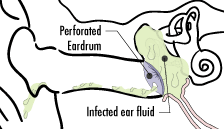You should keep the ear canal clean and dry until you see your doctor after surgery (usually 3 weeks after surgery). During normal activities, keep a clean cotton ball in the ear canal. You can change the cotton as often as needed. You will probably need to change it quite often during the first few days if the ear has bleeding or other drainage.
During baths or showers, coat a cotton ball with ointment (bacitracin, Vaseline®, or triple antibiotic ointment) and place it in the ear canal. The ointment will prevent water from seeping into the ear canal. After bathing, replace the cotton with a fresh, clean, and dry cotton ball.
If your child had a postauricular tympanoplasty the ear was likely bandaged with a gauze dressing and a velcro strap. You may remove the strap and gauze the day after surgery. Keep the back of the ear dry for 3 days after surgery. You can then get the back of the ear wet. Pat the area dry after showers or baths—do not rub. If there are little tapes on the skin (Steri-Strips™) let them fall off on their own. They may even stay in place until you see your doctor for follow-up after surgery.
In most cases, your child may return to his or her regular activities within 1 or 2 days after surgery. There is no need to restrict regular activity after your child feels back to normal. Vigorous exercise (such as swimming and running) should be avoided until you see your doctor after surgery (usually 3 weeks).
If your child complains of pain in the ear you can safely give Tylenol®, Children’s Motrin®, or other pain medicine prescribed by your doctor. If you are not sure what medicines are safe, please call your doctor.
 Many parents are concerned that a hole in the eardrum will cause permanent hearing loss. This is almost never the case. In fact, many perforation don’t even cause a temporary hearing loss. The effect a perforation has on hearing depends on the size of the hole and where it is located on the eardrum. Luckily, most perforations are relatively small and in areas that don’t affect the hearing too much.
Many parents are concerned that a hole in the eardrum will cause permanent hearing loss. This is almost never the case. In fact, many perforation don’t even cause a temporary hearing loss. The effect a perforation has on hearing depends on the size of the hole and where it is located on the eardrum. Luckily, most perforations are relatively small and in areas that don’t affect the hearing too much.